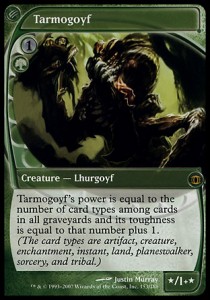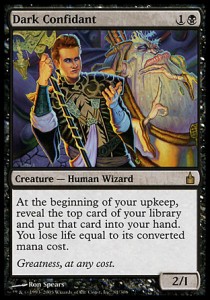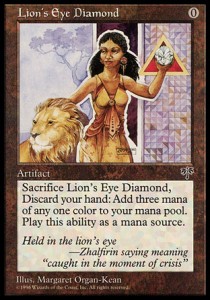This week we are going to be covering cards that are very good in Legacy but often misjudged to those who are newer to the format. If you are already an experienced Legacy player, this article is not for you. This article is aimed at players who have little to no Legacy knowledge, and we’d like to introduce to you the reasons why these commonly seen cards are played in Legacy. We have seen many players (online and otherwise) ask “Why is card xx so good? It seems pretty underwhelming.” Well hopefully this article will help Dispel some of those questions. Again, if you already know why the first card on this list is good, then you’ve been warned: this article may bore you. Otherwise, read on!
Tarmogoyf is probably the one card that gets the most questions – most often because it is coupled with its price tag, which peaked at $50 during its Standard days, and once it went to its low of about $30 after rotation, never went below that price. After the announcement of Modern, it quickly gained to almost $100 and continues to hover around that price.
Often times the question is “Well okay, it can be an 8/9 for two mana, but how often does that happen?” The answer is never. It definitely is possible to get a Tarmogoyf to an 8/9, but don’t count on it. The key to Tarmogoyf is not how big you can get him, but how efficient he can be. If you are willing to pay 1G for a 3/4 or a 4/5, then you’re looking in the right direction. Since Legacy contains some of the most powerful cards there are in Magic, you are looking for speed and efficiency, and Tarmogoyf can provide both.
Legacy is a format of fast cards. Consequently, graveyards fill up quickly. Activating a fetchland turn one already grows Tarmogoyf, and grows even further with a turn one Thoughtseize, Ponder, or Swords to Plowshares. Tarmogoyf typically enters the game as a 3/4, and with combat, easily become a 4/5. Countering or destroying artifacts or enchantments only add to the power of Tarmogoyf. One idea to see Tarmogoyf as better is to always expect him as a 3/4 or 4/5; anything higher is just a bonus.
As an aside, there is a neat trick with Tarmogoyf. He also can avoid burn spells due to the way the rules work. For example, if Tarmogoyf is a 2/3 with a land and creature in the graveyard and your opponent casts Lightning Bolt on Tarmogoyf, he will actually turn into the 3/4 and survive the Bolt. The reason why is because Lightning Bolt is placed in the graveyard as the final part of its resolution and grows Tarmogoyf to a 3/4 before state-based actions check to see if a creature has lethal damage on it.
In addition, Tarmogoyf’s low mana cost of 1G minimizes tempo loss in case your opponent Removes it. For example, if you were to tap out on turn 5 to cast a Baneslayer Angel, then your opponent taps two swamps and Doom Blades it, your opponent tap two mana to Time Walk you, since you spent your entire turn 5 to cast a single spell that your opponent neutralized for only two mana. Compare to Tarmogoyf: he is two mana versus Legacy’s removal of choice, Swords to Plowshares. Your opponent spent one white mana to Remove a two mana spell. Although you did lose in that tempo exchange, you still minimized your loss by spending only two mana on Tarmogoyf.
Lastly, his splashability is one reason for his power. Red Death, a black suicide deck splashing red, ditched the entire color red in favor of green for one reason: Tarmogoyf. Well, Krosan Grip too, but that was more of a bonus. For awhile, even Merfolk decks ran Tarmogoyf. The one green mana in its mana cost, along with fetchlands and duals in Legacy, make it extremely easy for almost any deck to play Tarmogoyf. The only times you didn’t want to play Tarmogoyf at his peak were if you were a tribal deck (though there were even exceptions to that rule) or a combo deck.
Now, we do realize that Tarmogoyf has fallen out of favor; Green Sun’s Zenith allows for more options in Tarmogoyf’s spot and Scavenging Ooze does outgrow and Shrinks Tarmogoyf as well. But we feel that his presence is still important in Legacy and is typically one of the most commonly asked-about cards in Legacy.
Dark Confidant is another card that turns ears simply because of its price tag, as well as its nickname – “Bob”. First of all, the reason why it’s nicknamed “Bob” is because a pro player named Bob Maher won a now-defunct tournament hosted by Wizards named the Invitational, where the winner gets to design a card with his or her likeness as the art. Dark Confidant is Bob’s addition to Magic. You may recognize Snapcaster Mage as being another invitational card, designed by Tiago Chan. Other invitational cards include Meddling Mage (Chris Pikula), Ranger of Eos (Oliver Ruel), and Shadowmage Infiltrator (Jon Finkel).
Anyway, the reason why Dark Confidant is good is because the life loss is often worth the card advantage. If one player draws two cards a turn, versus his opponent’s one card a turn, who will most likely win? The player that has the most cards of course – but, a common question is, why not play Phyrexian Arena? It’s only one mana more, and you don’t as much life! Well, that’s what it seems like on the surface. But there are many more reasons why Bob is better.
The first reason is that he is two mana. The difference in mana costs seems linear, but it’s actually exponential. The difference between two mana and one is very small, but the difference between three and two is a lot higher. The difference between three and four is so big that the four mana spell better win you the game at that point, or give you a good chance to pull far ahead of your opponent (Jace, the Mind Sculptor). In Legacy, mana cost matters a lot. Unmake, we should agree, is a better card than Swords to Plowshares, if you ignore the mana cost. But because Legacy depends so much on powerful cards at lower mana costs due to its faster nature, Unmake is unplayable; the “drawback” of Swords to Plowshares can be compensated for very quickly.
The second reason is the fact that Dark Confidant is a creature. If that Dark Confidant is going to kill you because you’re at a low life total, Dark Confidant is easy to kill off if necessary. But this also means that Dark Confidant can kill your opponent too, something Phyrexian Arena can’t do (short of Opalescence, at least). Decks that run Dark Confidant also tend to run Umezawa’s Jitte, so they can gain life in a pinch or even give their own Dark Confidants -1/-1 to rid themselves of the life loss.
The last reason has to do with the Legacy metagame. As you’ve no doubt read already, Legacy is a format of low cost, high impact cards. That means drawing more cards can swing games in your favor much, much faster. In addition, because all of these high impact cards are lower costed, it means that you won’t be losing as much life as you think to Dark Confidant. The average mana cost of many decks run from about 1 CMC to 2 CMC. Don’t forget, lands count as a 0 CMC card and with decks running around 20 land, that’s plenty of blanks you will flip off of Dark Confidant. Finally, with all of the deck manipulation that Legacy has to offer such as Brainstorm, Ponder, and the favorite of an older Extended, Sensei’s Divining Top, life loss from Dark Confidant can be minimized.
Lion’s Eye Diamond
This is probably the other card that gets the most questions. In fact it’s perfectly suitable for all of these questions, because it was invented with the idea of being a bad Black Lotus. And well… it’s basically a Black Lotus put in the right deck.
As you can see, it’s obviously a zero mana artifact that produces 3 mana along with a free One with Nothing. The crazy thing is that discarding your hand can actually be relevant in Legacy! In Storm decks, a common play is to cast a spell, then without passing priority, activate Lion’s Eye Diamond. For example, if you cast an Infernal Tutor with cards in hand, you can activate Lion’s Eye Diamond in response in order to achieve hellbent for the tutor. When Infernal Tutor resolves, not only do you have hellbent so you can search for any card, you also get the three mana from Lion’s Eye Diamond! At this point, it is for all intents and purposes a Black Lotus. Burning Wish plus Lion’s Eye Diamond also allows you to grab a game winning sorcery out of your sideboard and have three additional mana to cast it. You’ll have no other cards in your hand, but typically storm decks run disruption such as Thoughtseize or Duress to rip Counterspells out of their opponent’s hand.
Some builds of Dredge also run Lion’s Eye Diamond. It’s a free discard outlet plus mana that, with Breakthrough and Cephalid Coliseum, can be quite deadly and allow Dredge a turn one or two kill. However, many players choose to eschew Lion’s Eye Diamond because they feel that Dredge is too inconsistent with it, instead picking a build of Dredge that focuses on consistency over explosiveness Builds without Lion’s Eye Diamond cannot win on turn one while Lion’s Eye Diamond builds can.
That’s not all
Tarmogoyf, Dark Confidant, and Lion’s Eye Diamond. Three undeniably powerful cards in Legacy, but that’s not all. Unfortunately we don’t have enough space for this week. In the future, we’ll cover more misunderstood Legacy cards, but for next week we’ll return to budget decklists. See you all next week!
Jason and Jeff




Leave a Reply